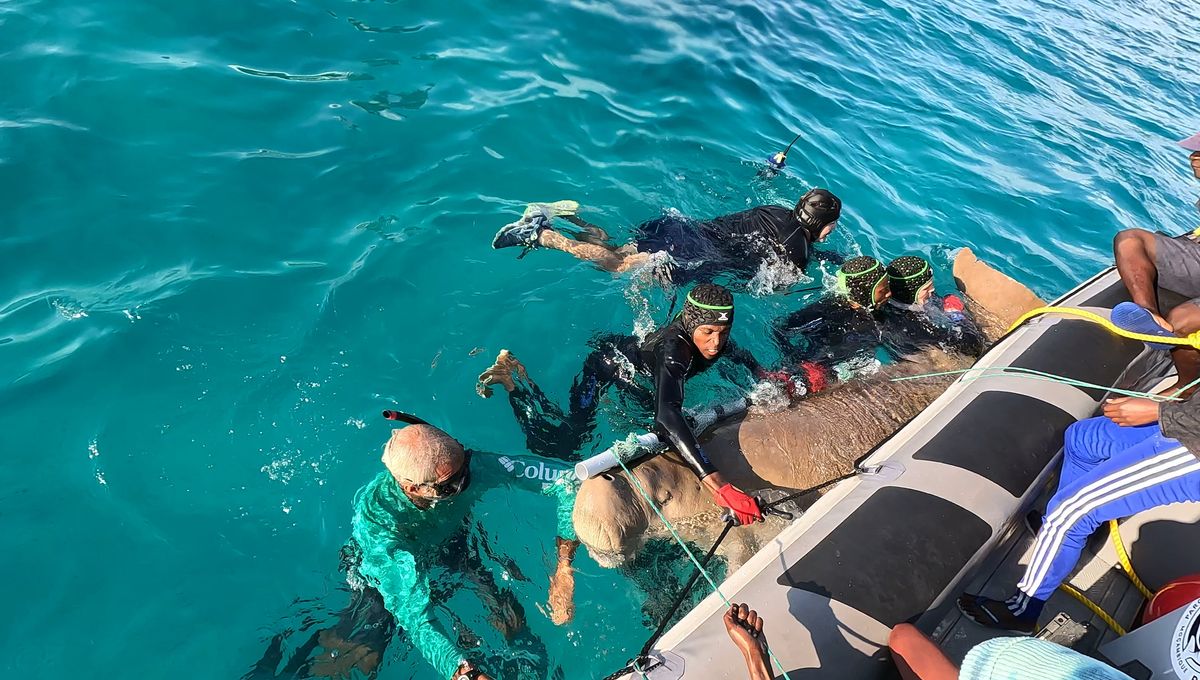
Once mistaken for mermaids, dugongs – also known as sea cows – are gentle marine giants. However, while some populations are surviving worldwide, a critically endangered sub-population of dugongs found along the coast of Mozambique is unfortunately not one of those. Luckily, scientists and the local community have come up with a plan to help save the dwindling population.
Dugongs were once common along Africa’s east coast but now the numbers of these gentle marine herbivores have declined significantly with just a few hundred left. The reasons for this decline are largely attributed to the fishing industry, with gill nets and seine nets causing the dugongs to become tangled and drown.
Further problems arise with the decline in seagrass habitat – a dugongs primary food source – as well as the commercialization of coastal areas causing increased boating and pollution.
However, the dugongs are safeguarded in one area, the Bazaruto Archipelago National Park, a protected area that is free from the use of any of the deadly nets. Conservationists have launched a new plan to use satellite tagging on the remaining members of the dugong population to provide critical information on their habitat use, including where they travel to and when they leave the protected area.
Recent aerial surveys have put their numbers at around 250 individuals including some cow and calf pairs, but the hope is this tagging data will contribute to conservation practices.
“Understanding dugong movements and habitat use is vital for the long-term protection of the species and their marine environment. But there is still much work to be done,” Evan Trotzuk, African Parks’ Research and Monitoring Coordinator at Bazaruto, told IFLScience.
“The East African population of dugongs status is relatively unknown in about 50 percent of its range areas. Since dugong movements are predominantly individualistic, it’s essential that at least 10 percent of a dugong population count is tagged to gain reliable data and to obtain the big picture of habitat use to identify movement corridors.”
There are a number of challenges, however, when it comes to tagging the dugongs. Unlike whales, which can be suction tagged from a distance or those that can be sedated safely, dugongs have to be awake for the process.
“Attaching the tracking devices required lots of planning and careful preparation. Weather, tides, and chance all played their part. The Bazaruto team was fortunate to learn from the expert team at James Cook University and this transfer of skills will be vitally important for the future – six of the park’s locally employed staff were trained to carry out the capture, tagging, and sampling of dugongs. This tagging exercise is a first for Africa and the Bazaruto team now has the skills needed to continue these efforts,” explained Trotzuk.
The African Parks team were part of an important project in 2022 that saw the dugong population in this area listed as critically endangered. Dugongs occur in other regions, including north Australia, which is why their overall classification remains at Vulnerable. The sea cows also play a vital role in maintaining the health of the ecosystem, and by doing this they support livelihoods in the region.
“Dugongs support the health of seagrass meadows by grazing preferentially on certain species. Seagrass meadows are critically important in East Africa for fisheries, which provide economic livelihoods and food security for coastal communities, and carbon sequestration,” continued Trotzuk.
Fortunately, it seems the tide may be turning in favor of the dugongs. The team have been working with local communities to reduce the threats to the species and engage the locals with the dugong research project.
“The Bazaruto Archipelago National Park management team has been working with local fishing communities to reduce the use of gill nets and improve the management of seine netting,” Trotzuk said.
“Despite some misconceptions amongst local anglers about marine conservation efforts and regulations, these efforts are beginning to pay off. Having seen the value of protecting aquatic life for healthy ecosystems, fish stocks, and tourism, local anglers are beginning to avoid using gill nets. In recent meetings to raise awareness ahead of the dugong tagging initiative, communities were enthusiastic and in favour of the project.”
The team have successfully tagged seven males and four females, with data already coming back to the team that shows where the individuals are heading. The team hope they can include an area north of the current Marine Protected Area (MPA) in the future as this is known to be an area the dugongs have been seen in.
“The area in the north is of particular focus for further protection measures as it has previously been noted as a dugong hotspot. The data from the tags will go a long way in determining the extent of the area that needs to be included in the MPA.”
Source Link: Africa's First Ever Dugong Tagging Project Hopes To Save Population From Extinction